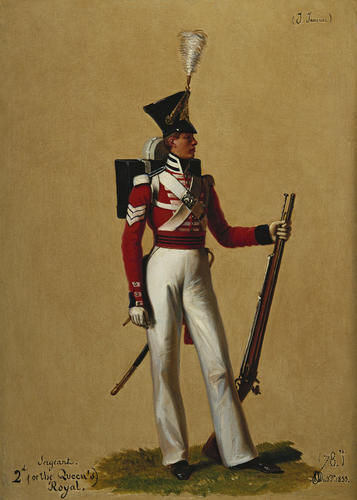-
1 of 253523 objects
Sergeant Alexander Jameson (b. 1811), 2nd (or the Queen's Royal) Regiment of Foot Signed and dated 1833
Oil on card | 35.1 x 25.3 x 0.2 cm (support, canvas/panel/stretcher external) | RCIN 407011

Alexandre-Jean Dubois Drahonet (1791-1834)
Sergeant Alexander Jameson (b. 1811), 2nd (or the Queen's Royal) Regiment of Foot Signed and dated 1833
-
In 1832 French portraitist Alexandre-Jean Dubois Drahonet was commissioned by William IV to paint one hundred pictures illustrating the uniform of the British Army. The Royal Collection retains most of this series. A photograph of the Equerry’s Room at Windsor Castle taken in around 1900 shows some of these paintings hanging together, framed in groups.
During the period of peace following the Napoleonic Wars, increasingly elaborate (and often quite impractical) military attire was devised, particularly by George IV. By the time William IV came to the throne in 1830, uniforms had become too expensive and were simplified and adapted once again. The result of these changes was codified and promulgated in the 1831 Dress Regulations. These paintings were intended to provide a visual record of the recent changes to military dress. Their value is not only historical, however, but also aesthetic: Drahonet produces lively, slightly elongated figures, capturing their facial expressions and setting them in a variety of organic poses.
Each painting in the series depicts a single figure against a neutral background. Although their uniform and accoutrements are the focus, the sitters are often identified by name, as well as regiment and rank. Shown here is Sergeant Alexander Jameson of the 2nd (Queen’s Royal) Regiment of Foot, a Line Infantry regiment.
In this painting, Jameson models the full uniform and accoutrements of the Line Infantry, including the single-breasted coatee with lace loops, the white trousers permitted in the summer months, and the shako with white plume newly approved for the regiment. In addition to the knapsack visible behind him, Jameson carries a carbine, bayonet and sword. His rank is indicated by the three chevrons on his sleeve. His epaulettes and other ornamentation are white rather than the gold reserved for Officers.
Provenance
Commissioned by William IV; recorded in the Equerries Room at Windsor Castle in 1878
-
Creator(s)
-
Medium and techniques
Oil on card
Measurements
35.1 x 25.3 x 0.2 cm (support, canvas/panel/stretcher external)
Other number(s)
JSS 68